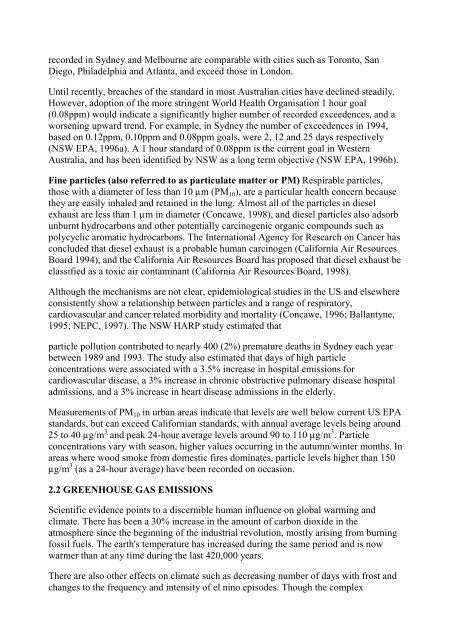National Fuel Quality Standards Regulation Impact Statement 1 ...
National Fuel Quality Standards Regulation Impact Statement 1 ...
National Fuel Quality Standards Regulation Impact Statement 1 ...
You also want an ePaper? Increase the reach of your titles
YUMPU automatically turns print PDFs into web optimized ePapers that Google loves.
ecorded in Sydney and Melbourne are comparable with cities such as Toronto, San<br />
Diego, Philadelphia and Atlanta, and exceed those in London.<br />
Until recently, breaches of the standard in most Australian cities have declined steadily.<br />
However, adoption of the more stringent World Health Organisation 1 hour goal<br />
(0.08ppm) would indicate a significantly higher number of recorded exceedences, and a<br />
worsening upward trend. For example, in Sydney the number of exceedences in 1994,<br />
based on 0.12ppm, 0.10ppm and 0.08ppm goals, were 2, 12 and 25 days respectively<br />
(NSW EPA, 1996a). A 1 hour standard of 0.08ppm is the current goal in Western<br />
Australia, and has been identified by NSW as a long term objective (NSW EPA, 1996b).<br />
Fine particles (also referred to as particulate matter or PM) Respirable particles,<br />
those with a diameter of less than 10 µm (PM10), are a particular health concern because<br />
they are easily inhaled and retained in the lung. Almost all of the particles in diesel<br />
exhaust are less than 1 µm in diameter (Concawe, 1998), and diesel particles also adsorb<br />
unburnt hydrocarbons and other potentially carcinogenic organic compounds such as<br />
polycyclic aromatic hydrocarbons. The International Agency for Research on Cancer has<br />
concluded that diesel exhaust is a probable human carcinogen (California Air Resources<br />
Board 1994), and the California Air Resources Board has proposed that diesel exhaust be<br />
classified as a toxic air contaminant (California Air Resources Board, 1998).<br />
Although the mechanisms are not clear, epidemiological studies in the US and elsewhere<br />
consistently show a relationship between particles and a range of respiratory,<br />
cardiovascular and cancer related morbidity and mortality (Concawe, 1996; Ballantyne,<br />
1995; NEPC, 1997). The NSW HARP study estimated that<br />
particle pollution contributed to nearly 400 (2%) premature deaths in Sydney each year<br />
between 1989 and 1993. The study also estimated that days of high particle<br />
concentrations were associated with a 3.5% increase in hospital emissions for<br />
cardiovascular disease, a 3% increase in chronic obstructive pulmonary disease hospital<br />
admissions, and a 3% increase in heart disease admissions in the elderly.<br />
Measurements of PM10 in urban areas indicate that levels are well below current US EPA<br />
standards, but can exceed Californian standards, with annual average levels being around<br />
25 to 40 µg/m 3 and peak 24-hour average levels around 90 to 110 µg/m 3 . Particle<br />
concentrations vary with season, higher values occurring in the autumn/winter months. In<br />
areas where wood smoke from domestic fires dominates, particle levels higher than 150<br />
µg/m 3 (as a 24-hour average) have been recorded on occasion.<br />
2.2 GREENHOUSE GAS EMISSIONS<br />
Scientific evidence points to a discernible human influence on global warming and<br />
climate. There has been a 30% increase in the amount of carbon dioxide in the<br />
atmosphere since the beginning of the industrial revolution, mostly arising from burning<br />
fossil fuels. The earth's temperature has increased during the same period and is now<br />
warmer than at any time during the last 420,000 years.<br />
There are also other effects on climate such as decreasing number of days with frost and<br />
changes to the frequency and intensity of el nino episodes. Though the complex
















